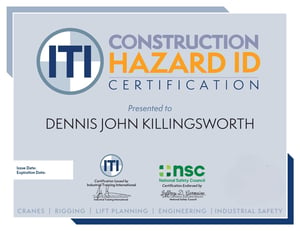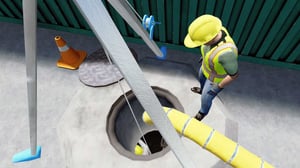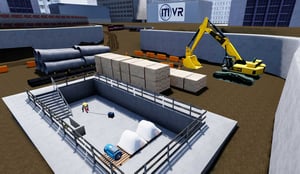

VR Training and Assessment for the NSC Hazard ID Certification
VR Application & Assessment
A practical, immersive assessment of construction hazards has not been available until now.
Construction hazards are plentiful, as are the training programs that address them like OSHA-10, online courses, and various internal safety courses.
Introducing the VR Construction Hazard ID Assessment as a major title in the ITI VR Industrial Skills Library. Construction Hazard ID is delivered through VR Headsets any place your people are! The practical assessment can be administered by nearly anyone and covers 10 risk domains. Start your application here!
Hazard ID Certification
Developed with the participation of the NSC, Bechtel, DPR Construction, GLY Construction, Kiewit, Liberty Mutual Insurance, and United Rentals, the VR Construction Hazard ID experience challenges candidates to inspect a jobsite and identify several risk domains including hand tools, lock out/tag out, lifting and rigging, dropped objects, and more.

10 Risk Domains Assessed
| 1. Hand Tools 2. Lifting and Rigging 3. Electrical and Lockout/Tagout (LOTO) 4. Environmental Hazards 5. Confined Space and Hot Work |
6. Mobile Equipment and Personnel Interface (MEPI) and Excavations 7. Dropped Object Prevention/Protection 8. Fall Prevention/Protection 9. Scaffolding 10. Industrial Hygiene* |
*This may include items such as silica dust and noise.

Development & Hardware
In a January 2020 survey conducted by ITI, with 184 respondents, 67% of all respondents said that their organization would likely rely on a three-five year construction safety certification based on a VR exam, and 75% of managers and owners saw a positive benefit from such a certification.


Construction Hazard ID is compatible with the following VR Headsets and Hand Controllers:
- HTC Vive Focus Plus & Vive Focus 3
- Oculus Quest 1 & Quest 2
- Oculus Rift & Rift-S
- Oculus Go
Certification, Policies & Application
Certification candidates include anyone who is going to be working on or around an active construction site whether novice, journeyman, foreman, architect, electrician, or any other trade and/or role.
There are no prerequisites for the assessment. Training that includes a cross section of topics from OSHA 29 CFR 1926 can be taken by candidates prior to the exam. This training, though not required, is highly recommended.


